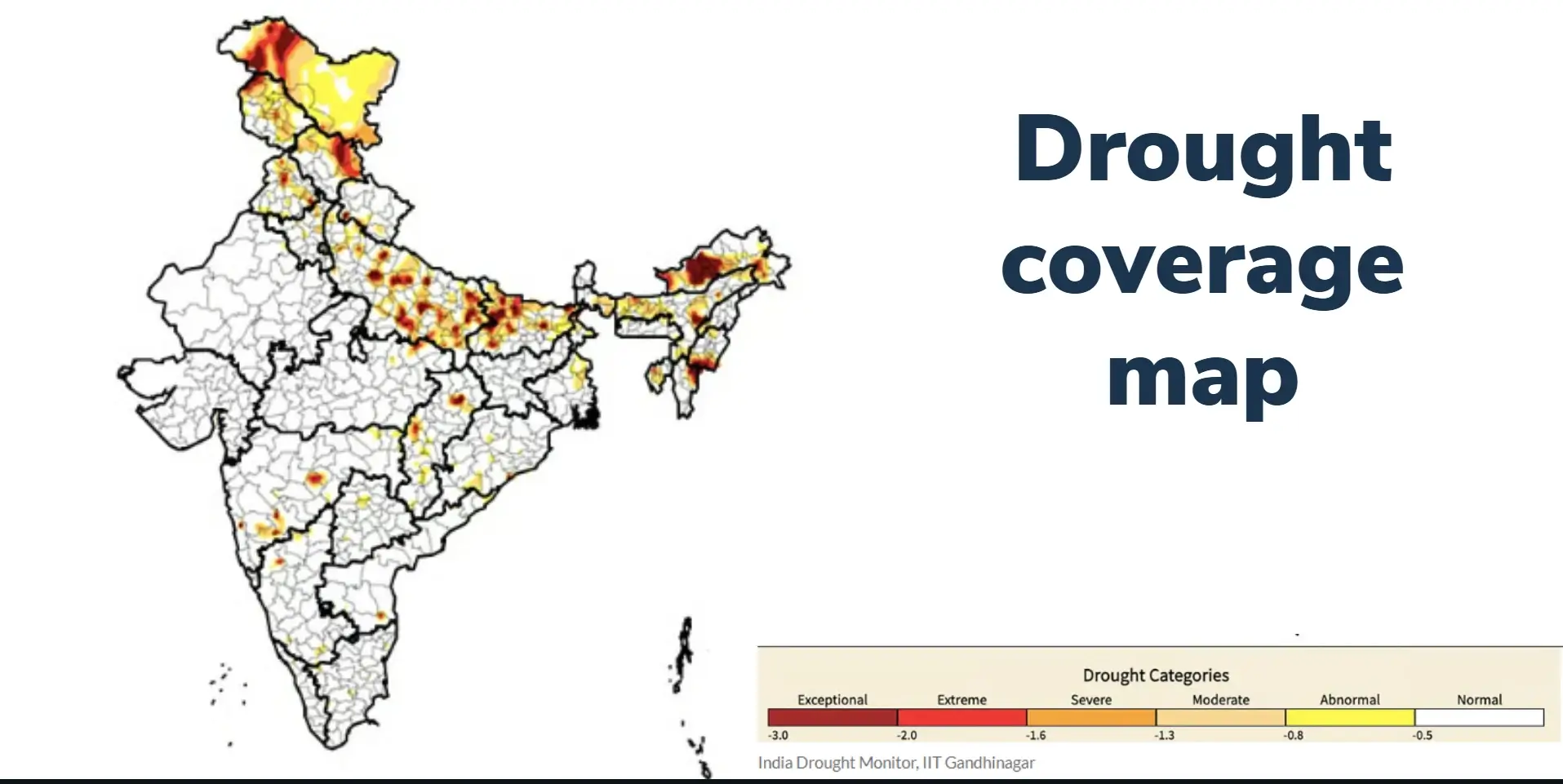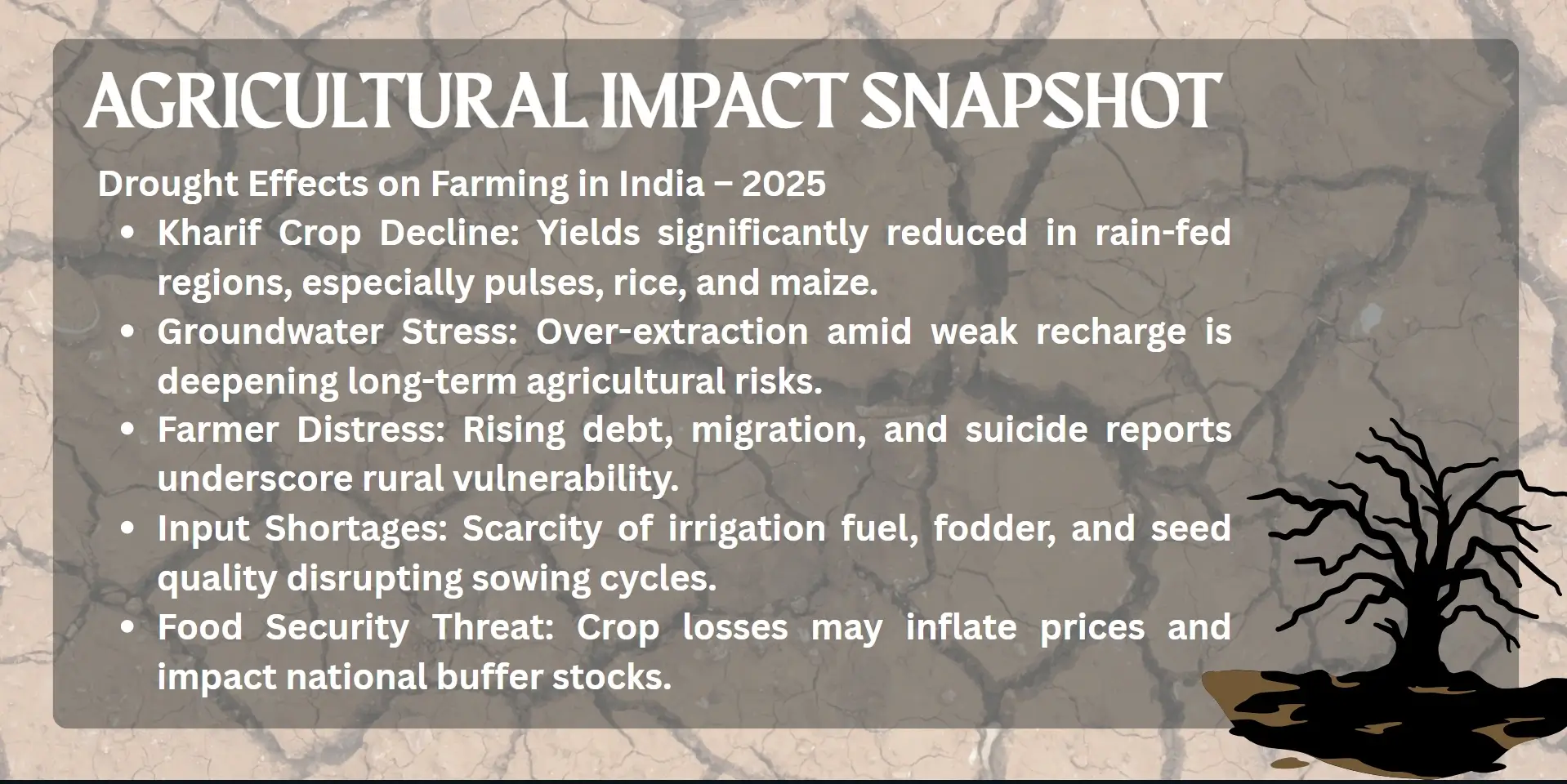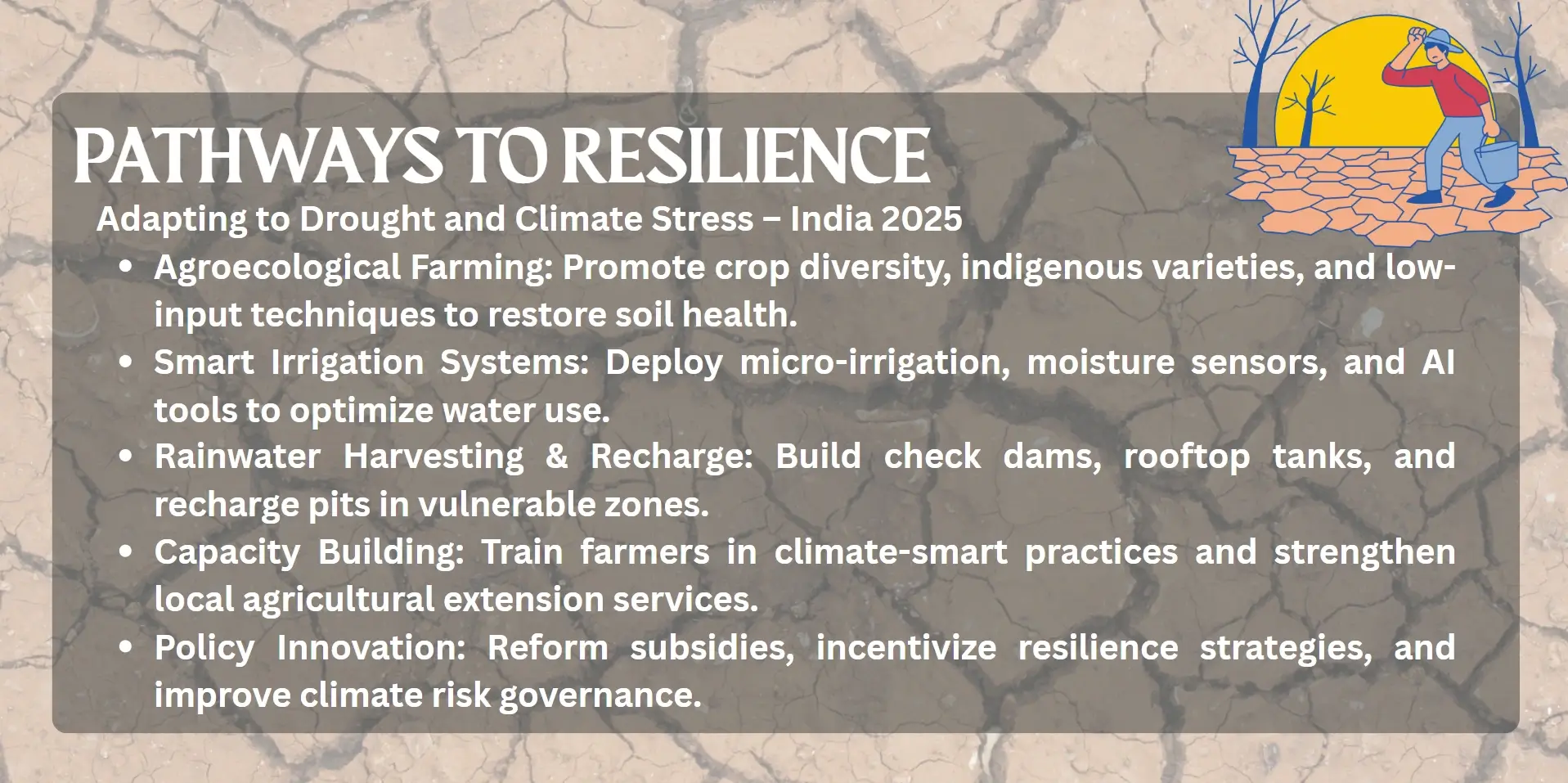Parched Despite the Pour is a phrase that describes a situation where, despite receiving a downpour of rain, the ground or an object remains excessively dry or thirsty. This can be due to various factors like the intensity of the rain not being enough to penetrate deeply, the ground being too compacted, or a high rate of evaporation.Even after an above-normal monsoon rainfall, which occurred in certain parts of India during the first half of the year, 19 per cent of India is facing drought,especially because of the uneven distribution of rainfall and climate change, accompanied by poor water management that has affected the livelihoods and agriculture.

Rainfall ranging between 96 and 104% of this 50-year average is considered "normal". The monsoon plays a critical role in India's agriculture sector, which supports the livelihood of around 42% of the population and contributes 18.2% to the national GDP.Although the 2025 monsoon season began relatively well with above normal rainfall, almost nineteen percent of India now faces drought or drought-like conditions as indicated by the Drought Early Warning System (DEWS). This irony of abundant rainfall and a scarcity of water has brought forward serious concerns about the nature in which Indian climate is changing, how vulnerable its water systems are, and the effectiveness of its drought mitigation plans. Even wildly varying states such as Ladakh, Himachal, Bihar, Uttar Pradesh, Punjab, the states in the Northeast (near the Chinese border) like Arunachal Pradesh, Manipur, Mizoram and Assam are reeling under an extreme drought situation with agriculture, drinking water and the livelihood of millions at risk.The phenomenon highlights one important truth; the overall amount of rainfallare not the guarantee of water security. Incomplete distribution, brief high-intense rain, low absorption to the soil and infrastructure deficiency may make even a wet season ineffective. With rising climate variability, in India, the uncoupling of rainfall and Drought risknecessitates a better insight into hydrological variation, land use shift, and governance failure. This Article deals with the motives of such an anomaly, its effects on the region where it is taking place, as well as the necessity of the region to have resilient, data-driven policies to help in combating the anomaly. It tries to illuminate how India can more effectively anticipate and adjust to such paradoxes of a warming world.
Knowing the Paradox
Looking at the recent incidents where there are the incidents of excess rainfall but despite it there is a drought in some parts of the country. This paradox masks still more serious problems of rainfall distribution, soil process and climate variability.
Uneven Distribution
Although statistics on the rainfall shows that the region has a surplus, the situation on the ground is much different. The monsoons in India are becoming more sporadicnot only in terms of a dangerously fast downpour before a long dry period. Such bursts mostly result into surface runoff instead of recharging groundwater and soil moisture level becomes dangerously low. Rains have been concentrated in isolated events in many places, particularly the Indo-Gangetic plains and in the foothills of the Himalayas, which failed to meet the requirements of agricultural cycles and refilling of reservoirs.
Soil Moisture Deficit and Hydrological Disconnect
Drought is not only a measure of the amount of rain but how water can be conserved and used. Unhealthy soil conditions, forest clearance and deterioration of land have made the land less efficient in terms of its ability to absorb and hold water. States such as Punjab and Uttar Pradesh have intensively cultivated soils to such an extent that soils are compacted and further resulting in runoff, thereby decreasing infiltration. Rain, though, fails repeatedly to make its way into deposition as usable water to crops or water tables, further shoring up the drought imprint.
DEWS indicators
Drought Early Warning System (DEWS) uses a multidimensional measure to index drought conditions; i.e., rainfall deviation, vegetation stress, and soil moisture anomaly are also considered in the measure. The most recent data indicates that even though monsoon rains have arrived early as compared to recent times, there is still a dangerously low vegetation index and soil moisture levels over nineteen percent of India. This implies that rainfall is not a sufficient criterion for drought measurement. According to DEWS, the significance of coordinated hydrology surveillance is clearly defined in order to portray the entire image of water stress.
Regionalization of extreme drought
The situation of drought in India is not evendue to the fact thatit fluctuates dramatically, whether it is found in one area or another. The impact of water shortage is worsened by the fact that each of the affected states is burdened with unique ecological, agricultural, and climatic issues.
Ladakh & Himachal Pradesh
Drought has become a reality in Ladakh and parts of Himachal Pradesh despite the fact that they are hilly and also have sources of glaciers. Horizontal movement by glaciers and lessening of snow and unusual precipitation patterns have interrupted conventional ocular waters. These areas depend much on seasonal streams and use of snowmelt, which is today drying early. There is also a deficient vegetation cover and insufficient water storage facilities that serve to compound the vulnerability which endangers agriculture and some local biodiversity.
Bihar and U.P
India has been in serious agricultural distress in Bihar and Uttar Pradesh which are major producers of food grains. Fields have been left parched due to odd distribution and very long dry spells even though the early monsoon rains came. The levels of groundwater which have been reduced over the years through excessive pumping, have not revived. Water stress is particularly sensitive where Paddy is the major crop especially in these areas where people fail in their crops and other people suffer economically because of great numbers of farmers.

Punjab
The over dependenceof the people of Punjab on ground water and water-intensive crops such as rice, which contribute to the drought experienced in the region, is systemic in nature. Although there were higher than normal rains during the early monsoon, they were not at optical weather patterns to ensure planting times and the replenishment of aquifers. The canal networks of the state are experiencing overload and downward movement in groundwater tables is being experienced. Unless cropping patterns and irrigation practice are changed, the situation of water crisis in Punjab might be irreversible.
Northeast States
Southern states such as Arunachal Pradesh, Manipur, Mizoram, and Assam have always been rich in rain and currently they are suffering because of drought state. Changes in monsoons, land clearing, and river basin interference in the flow have caused decreasing soil wetness and decreasing regularity of stream flowing. Poor infrastructure on the storage and distribution of water does not help the cause of these states as well since they are very prone to short-time changes in rainfall.
Climatic and Environmental Drivers
The worsening drought situation in India even during above-normal precipitation in many parts of the country can be attributed to more fundamental climatic and environmental changes. The drivers are re-shaping the hydrological cycles and enhancing vulnerabilities in various landscapes.
Increase in Temperature and Evapotranspiration Stress
The constant increment in the surface temperatures of India is one of the greatest factors that lead to drought. Warm temperatures increase the rate of evapotranspiration a condition whereby water evaporates out of the soil and through transpiration through the plants resulting in a fast loss of water. Where rainfall occurs, the additional heat leads to evaporation of the water as opposed to absorption or storage. It is especially severe in semi-arid corridors and the agricultural belts that can no longer hold enough water and crops cannot grow normally, leading to decreased harvest.
Non-traditional Monsoon Dynamics
The volatility in India is now characterized by volatility in monsoon and this monsoon is no longer a relatively predictable seasonal system. The change in climatic status has caused erratic distribution of rainfall due to changes in wind patterns, ocean temperatures, and pressures. Many parts are seeing fierce downpours of clouds followed by long dry periods instead of continuously falling rains. Such incidents can result into adverse conditions. This has a particular impact on the Northeast and Himalayan areas as the usual rain-fed systems do not adjust to the patterns of these new rhythms.
Ecological Degradation and Change of Land Use
The decrease of the capacity of lands to retain water is tremendously affected by human-induced causes of land uses, which include deforestation, urban sprawl and unsustainable agricultural practices. The forests are being cleared to be developed thus affecting the normal rains experienced in the area because trees serve as natural sponges to the region and alsoenhancesoil permeability. Monoculture farming and application of chemicals in agricultural zones affect the soil structure in a negative way, making it less absorbent. Concrete urban places do not allow seepage, leading to excess surface run off and groundwater recharge.
The socioeconomic and agricultural impact
The drought that has been plaguing almost a fifth of India is not only a natural disaster, rather it is a socioeconomic tremor as well. It is undermining agricultural livelihoods, community health and stability in regions due to its ripple effects.
Food insecurity and crop failure
The drought conditions are being experienced in agriculture, which is the mainstay of rural India. Paddy, maize and pulses (off-season crops) are more reliant on uniform soil moisture and proper rain showers. Trade patterns have seen inconsistent rainfall and dries that have resulted inmassive crop failures in drought-stricken states. Farmers are experiencing a poor harvest, increased debts and insecurity of the next planting season. This poses a risk to food security in terms of adequacy and affordability, particularly to the poor households who spend their incomes in the area of production.
Drought and rural dejection
Other than agriculture, drought has also caused severe water deficiency of drinking, sanitation, and livestock. Drying wells and better access to clean waterare reported in many villages. Fetching of water from long distances is usually left to women and children, which impacts education and health. The reliance on tankers is on the increase in city outskirts, and it puts pressure on municipal finances and enhances the inequality between people when we see at the water consumption.

Migration and Livelihood loss
Due to the failure of agriculture, jobs in rural areas have gone down. Wage labourers and tenant farmers, smallholding peasants, are being denied daily income, with the likely result of distress migration to the cities. Such an influx weakens the inner infrastructure and causes poor living conditions in informal settlements. Demographic and economic changes are long-term and more so, in traditional farming, such as in Punjab and Assam, where young villagers are opting out altogether and moving to other occupations.
Health risks and social vulnerability
Drought increases health risks as there is malnutrition due to loss of crops; there are heat-related illnesses, and there is the prevalence of vector-borne diseases in stagnant water. Farmers are reporting cases of mental health problems, such as anxiety and depression due to crop failure in repeated occurrences. Women, children, and the elderly are more vulnerable, and hence they are affected disproportionately, reporting the necessity of social protection that should be focused on these aspects.
Governance issues and Policy gaps
The drought faced by India despite the early rain during the monsoons is an indication of the endemic policy gaps and governance issues in India.
- Alerts provided by such systems as DEWS are quite timely; however, institutional responses are still quite reactive and fragmented. Post-disaster alleviation actions, e.g. payment of losses in crops or water tankers run, become available only when desperation sets in and not in the form of prior planning on the knowledge of early warning.
- India has divided water management into various ministries and state departments which has resulted in lack of coordination and incoordination on how issues are implemented.
- As an example, groundwater management is in different jurisdictions to surface water or irrigation and therefore leads to policies operating in silos.
- In addition, mitigation against drought is hardly considered in the long-term development strategies. Such temporary relief is given in programs such as the Mahatma Gandhi National Rural Employment Guarantee Act (MGNREGA) which in spite of providing these short term solutions are not in line with sustainable water conservation or agro-ecological practices.
- It has also got the gaps between local realities and climate adaptation policies. Quite a number of drought susceptible areas do not have institutional ability to deploy resilience measures, including rainwater harvesting, diversification of crops production, or soil restoration.
- Independent of solid data-exchange, community involvement and inter-state planning, drought management is left to be fragmented. It is only by addressing them that the gaps between responding effectively to crises and rebuilding them systematically can and should be reduced through a change towards reformation, on the principles of a climate informed, cross-sector planning and integrated water policy that aims to respond on a long-term resilient perspective rather than in an emergency aid sense.
Pathways to resilience
To create resilience to drought in India would require a multidimensionalstrategy which would combine ecological restoration, innovation and inclusive governance.

- A major solution channel is to introduce practices of agroecology, including crop diversity, organic food production, and soil restoration to improve retention and help prevent the use of irrigation-intensive crops.
- Monoculture intensive water guzzlers like Punjab and Uttar Pradesh have to abandon them and switch to climate resilient varieties that are suited to the local conditions.
- Reforms on water management are also important. Buffer mechanisms Rains variability can be buffered by localized rainwater collecting, localized storage and recharging of the aquifers.
- Smart irrigation technology, such as drip irrigation, soil moisture sensors and others, can make irrigation more efficient, particularly in arid regions. Such interventions should be based on a strong data infrastructure with satellite monitoring and AI-based forecasting capability that enables the ability to act in a local, timely manner.
- Policy frameworks must favour long-term adaptation as opposed to short-term relief. Communities can be empowered to take proactive action against water stress by incorporating drought preparedness to rural development plans, financial incentive on sustainable farming practice, and better governance at local level.
- Trans-boundary water problems should be solved by inter-state coordination and open data-sharing. Conclusively, resilience does not only imply survival in drought situations but the ability to turn the very vulnerability into advantage based on systemic, inclusive and future-based approaches in line with the climate and development plans of India.
Conclusion
The recent drought crisis in India, where almost one of fifth part of nation urged to face water insecurity due to enhanced early monsoon precipitation, reveals a rather dangerous gap between climatic tendencies and water security. The given paradox is not simply a weather freak but reveals more fundamental underlying weaknesses: unstable rainfall patterns, soils weakness, inefficient water management, and climate-related pressure. The effects are far-reaching and multi-dimensional, whether in the brittle ecosystems of Ladakh, the groundwater crisis inPunjab, or changing rain regimes in the Northeast.There is a need to do more than reactive relief, but it needs a paradigm shift to resilience. Agroecological shifts, intelligent water management and a combined policy frameworks should be the key to the Indian drought strategy. The strengthening of local communities based on access to data, participatory planning and sustainability of livelihoods is equally important. Faced with rising climate variability, India needs to get off the rainfall-based models and terms, and adopt comprehensive science-based approaches to drought preparedness. It is only through this that the country can turn around its vulnerability into a long-term water and food security.